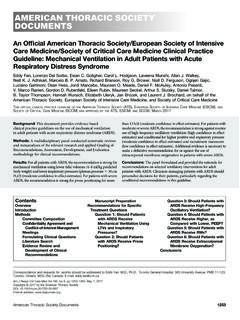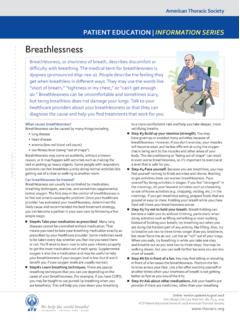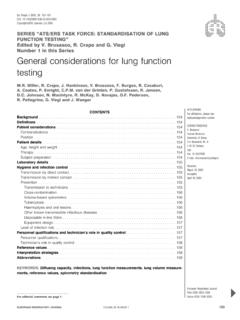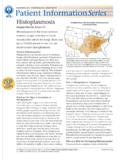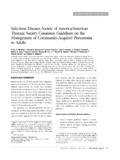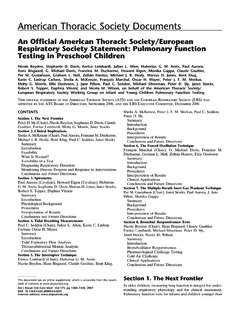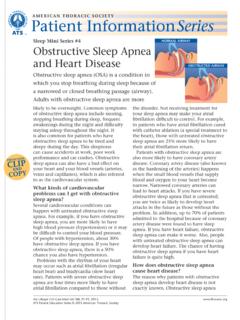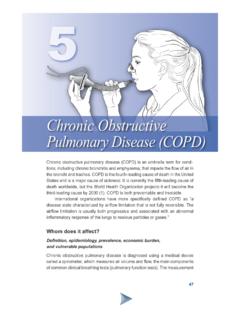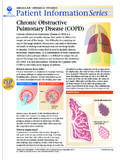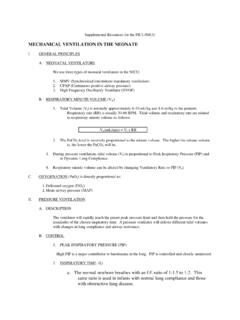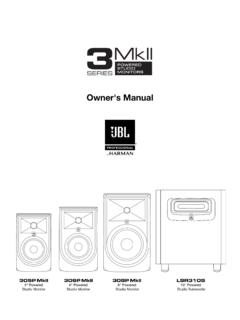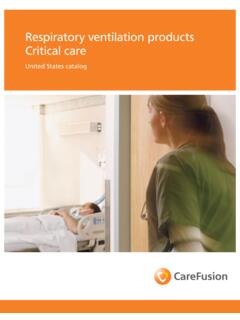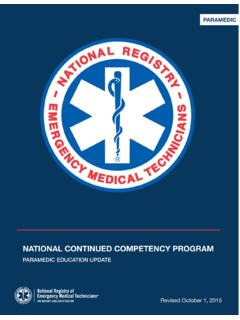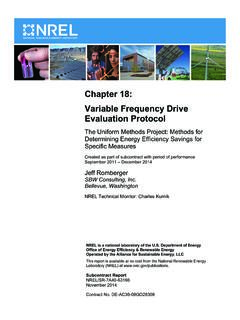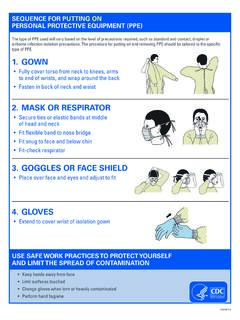Transcription of AMERICAN THORACIC SOCIETY DOCUMENTS
1 AMERICAN THORACIC SOCIETYDOCUMENTSAn Official AMERICAN THORACIC SOCIETY /European SOCIETY of IntensiveCare Medicine/ SOCIETY of Critical Care Medicine Clinical PracticeGuideline: Mechanical ventilation in Adult Patients with AcuteRespiratory Distress SyndromeEddy Fan, Lorenzo Del Sorbo, Ewan C. Goligher, Carol L. Hodgson, Laveena Munshi, Allan J. Walkey,Neill K. J. Adhikari, Marcelo B. P. Amato, Richard Branson, Roy G. Brower, Niall D. Ferguson, Ognjen Gajic,Luciano Gattinoni, Dean Hess, Jordi Mancebo, Maureen O. Meade, Daniel F. McAuley, Antonio Pesenti,V. Marco Ranieri, Gordon D. Rubenfeld, Eileen Rubin, Maureen Seckel, Arthur S. Slutsky, Daniel Talmor,B. Taylor Thompson, Hannah Wunsch, Elizabeth Uleryk, Jan Brozek, and Laurent J. Brochard; on behalf of theAmerican THORACIC SOCIETY , European SOCIETY of Intensive Care Medicine, and SOCIETY of Critical Care MedicineTHIS OFFICIAL CLINICAL PRACTICE GUIDELINE OF THEAMERICANTHORACICSOCIETY(ATS), EUROPEANSOCIETY OFINTENSIVECAREMEDICINE(ESICM),ANDSOCIET Y OFCRITICALCAREMEDICINE(SCCM)WAS APPROVED BY THEATS, ESICM,ANDSCCM, MARCH2017 Background:This document provides evidence-basedclinical practice guidelines on the use of mechanical ventilationin adult patients with acute respiratory distress syndrome (ARDS).
2 Methods:A multidisciplinary panel conducted systematic reviewsand metaanalyses of the relevant research and applied Grading ofRecommendations, Assessment, Development, and Evaluationmethodology for clinical :For all patients with ARDS, the recommendation is strong formechanical ventilation using lower tidal volumes (4 8ml/kgpredictedbody weight) and lower inspiratory pressures (plateau pressure,30 cmH2O) (moderate confidence in effect estimates). For patients with severeARDS, the recommendation is strong for prone positioning for morethan 12 h/d (moderate confidence in effect estimates). For patients withmoderate or severe ARDS, the recommendation is strong against routineuse of high - frequency oscillatory ventilation ( high confidence in effectestimates) and conditional for higher positive end-expiratory pressure(moderate confidence in effect estimates) and recruitment maneuvers(low confidence in effect estimates). Additional evidence is necessary tomake a definitive recommendation for or against the use ofextracorporeal membrane oxygenation in patients with severe :The panel formulated and provided the rationale forrecommendations on selected ventilatory interventions for adultpatients with ARDS.
3 Clinicians managing patients with ARDS shouldpersonalize decisions for their patients, particularly regarding theconditional recommendations in this CompositionConfidentiality Agreement andConflict-of-Interest ManagementMeetingsFormulating Clinical QuestionsLiterature SearchEvidence Review andDevelopment of ClinicalRecommendationsManuscript PreparationRecommendations for SpecificTreatment QuestionsQuestion 1: Should Patientswith ARDS ReceiveMechanical ventilation UsingLTVs and InspiratoryPressures?Question 2: Should Patientswith ARDS Receive PronePositioning?Question 3: Should Patients withARDS Receive high -FrequencyOscillatory ventilation ?Question 4: Should Patients withARDS Receive Higher, asCompared with Lower, PEEP?Question 5: Should Patients withARDS Receive RMs?Question 6: Should Patients withARDS Receive ExtracorporealMembrane Oxygenation?ConclusionsCorrespondence and requests for reprints should be addressed to Eddy Fan, , , Toronto General Hospital, 585 University Avenue, PMB 11-123,Toronto, Ontario, M5G 2N2 Canada.
4 E-mail: J Respir Crit Care Med Vol 195, Iss 9, pp 1253 1263, May 1, 2017 Copyright 2017 by the AMERICAN THORACIC SocietyDOI: address: THORACIC SOCIETY Documents1253 OverviewThe purpose of this guideline is to analyzeevidence on the use of ventilatory strategiesand associated cointerventions in adultpatients with acute respiratory distresssyndrome (ARDS) and to providetreatment recommendations on the basisof these interventions. For eachrecommendation, it is important toconsider the quality of the evidence reviewsand patient values and preferences beforeapplying these recommendationsto specificclinicalsituationsorpolicy decisions. No guideline orrecommendations can take into account allthe compelling and unique clinical featuresof individual patients, and thereforeclinicians, patients, policy makers, andother stakeholders should not regard theserecommendations as mandatory. Finally,although there may be good reasons toextrapolate these treatments to other causesof acute hypoxemic respiratory failure orto all mechanically ventilated patients, weexclusively reviewed data on patients withARDS, and recommendations therefore applyonly to this group of patients.
5 A summary ofour recommendations is as follows:1. The recommendationsforthe followinginterventions for the treatment of ARDSare strong:a. Mechanical ventilation using lowertidal volumes (4 8 ml/kg predictedbody weight) and lower inspiratorypressures (plateau pressure,30 cmH2O) (moderate confidence in effectestimates)b. Prone positioning for more than12 h/d in severe ARDS (moderateconfidence in effect estimates)2. The recommendationagainstthefollowing intervention for the treatmentof ARDS is strong:a. Routine use of high -frequencyoscillatory ventilation in patientswith moderate or severe ARDS (highconfidence in effect estimates)3. The recommendationforthe followinginterventions for the treatment of ARDSis conditional:a. Higher positive end-expiratorypressure in patients with moderate orsevere ARDS (moderate confidencein effect estimates)b. Recruitment maneuvers in patientswith moderate or severe ARDS (lowconfidence in effect estimates)4.
6 Additional evidence is necessary tomake a definitive recommendationfororagainstthe use of extracorporealmembrane oxygenation in patients withsevere regarding some modes ofmechanical ventilation ( , airway pressurerelease ventilation ) and complementarypharmacologic interventions ( ,neuromuscular blockade) were notaddressed because of resource questions are deferred to a futureversion of the is a life-threatening form ofrespiratory failurecharacterized byinflammatory pulmonary edema resultingin severe hypoxemia (1). The severity ofARDS is classifiedaccordingtothedegree of hypoxemia (PaO2/FIO2ratio),with mutually exclusive categories ofmild (PaO2/FIO2,201 300), moderate(PaO2/FIO2,101 200), and severe(PaO2/FIO2<100) (2). ARDS is common,is associated with substantial morbidity,is frequently fatal, and represents animportant public health problem (3 5).Despite decades of research, there arelimited therapeutic options directed at theunderlying pathological processes (6), andsupportive care with mechanical ventilationremains the cornerstone of patientmanagement (7).
7 With the understandingthat mechanical ventilation itself can causeand potentiate lung injury, research hasfocused on ventilatory strategies andadjunctive measures aimed at mitigating thisso-called ventilator-induced lung injury(VILI) (8). Importantly, ARDS appears to beunderrecognized by clinicians, and evidence-based interventions are underused (5). Thus,there is the potential for improved outcomesin patients with ARDS through enhanceduptake and implementation of evidence-based CompositionWe convened an interprofessional panelwith a broad sample of clinicalepidemiologists, clinical trialists,physiologists, and methodologists fromdifferent disciplines and jurisdictions as wellas an ARDS survivor ( ). On the basis ofinterest and expertise, panel members wereprimarily assigned to one of threeRecommendation subcommittees, eachchaired by a senior member. An additionalMethodology subcommittee included achair and two experts in systematic reviewand guideline methods as well as a medicallibrarian ( ).
8 Each subcommitteeincluded at least one senior investigator toprovide oversight and at least one juniorinvestigator to aid guideline development aswell as to gain valuable clinical, research,and methodological experience from leadersin thefield. The committee was cochaired and Committee membersrepresented the AMERICAN THORACIC SOCIETY (ATS), European SOCIETY of Intensive CareMedicine, and SOCIETY of Critical Agreement andConflict-of-Interest ManagementCommittee members signed conflict-of-interest statements. New or updatedconflicts of interest were solicited bythe Co-Chair ( ) at the start of eachin-person meeting and views and interests of the ATS, EuropeanSociety of Intensive Care Medicine, andSociety of Critical Care Medicine, or those ofany commercial entity that provided fundingto these professional societies, had noinfluence on the topics discussed andrecommendations a face-to-face meeting at the 2013 ATSI nternational Conference in Philadelphia,Pennsylvania, the panel discussed the scopeand objectives of the project and identifiedthe specific clinical questions to beaddressed.
9 An ATS methodologist ( )presented an overview of the Grading ofRecommendations, Assessment,Development, and Evaluation (GRADE)process for guideline development to thepanel. At the 2014 InternationalSymposium on Intensive Care andEmergency Medicine in Brussels, Belgium,the panel studied preliminary , at the 2014 ATS InternationalConference in San Diego, California, thepanel reviewed thefindings from theevidence summaries and drafted initialrecommendations. Conference calls ande-mail correspondence were used todiscuss specific issues requiring inputfrom other panel members, includingAMERICAN THORACIC SOCIETY DOCUMENTS1254 AMERICAN Journal of Respiratory and Critical Care Medicine Volume 195 Number 9|May 1 2017updated literature searches andevidence synthesis,finalizing therecommendations, and responding topeer Clinical QuestionsThe panel agreed on six specific questionspertinent to the ventilatory management ofcritically ill adults with ARDS.
10 The panelidentified outcomes of interest for eachquestiona prioriand rated their relativeimportance (from the perspective of apatient with ARDS) from not important to critical as per the GRADE framework (9).An example of a critical outcome ismortality. Ranking outcomes by theirrelative importance focuses attention onthose that are most relevant to patients andhelps to address potential disagreements SearchA medical librarian ( ) helped todevelop a search strategy for each of theguideline questions, using controlledvocabulary terms and text words toupdate existing systematic reviews(10 15). We evaluated existingsystematic reviews using the AMSTAR (AMeasurement Tool to Assess SystematicReviews) checklist (16). We searchedMEDLINE, EMBASE, Cochrane Registryof Controlled Trials, Database ofAbstracts of Reviews of Effects (OvidSP),CINAHL (EBSCOHost), and Web of Science(Thomson Reuters) from the date of the lastsystematic review to August 2016, withoutlanguage restrictions.
